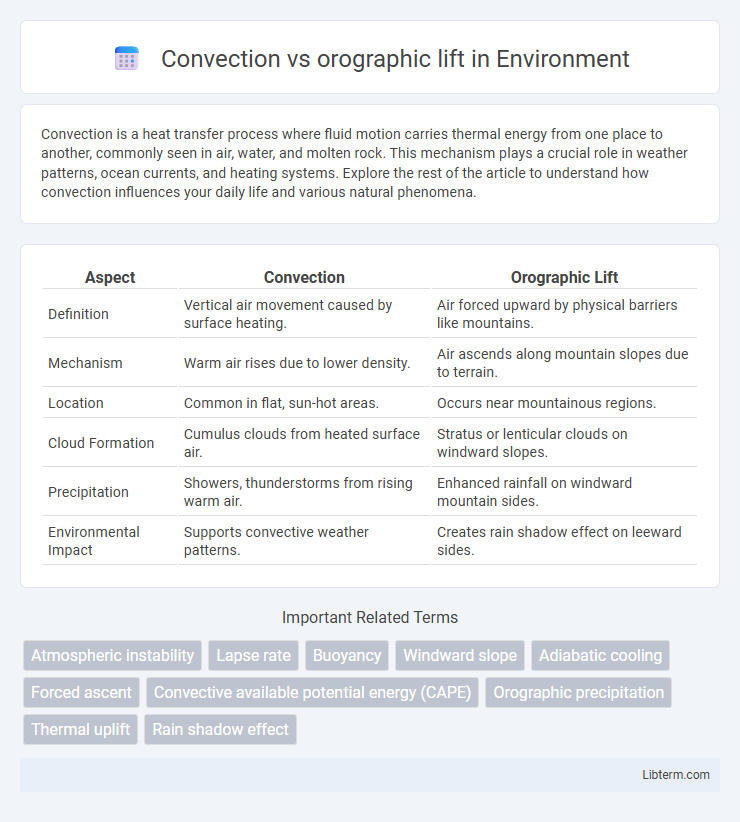Convection is a heat transfer process where fluid motion carries thermal energy from one place to another, commonly seen in air, water, and molten rock. This mechanism plays a crucial role in weather patterns, ocean currents, and heating systems. Explore the rest of the article to understand how convection influences your daily life and various natural phenomena.
Table of Comparison
| Aspect | Convection | Orographic Lift |
|---|---|---|
| Definition | Vertical air movement caused by surface heating. | Air forced upward by physical barriers like mountains. |
| Mechanism | Warm air rises due to lower density. | Air ascends along mountain slopes due to terrain. |
| Location | Common in flat, sun-hot areas. | Occurs near mountainous regions. |
| Cloud Formation | Cumulus clouds from heated surface air. | Stratus or lenticular clouds on windward slopes. |
| Precipitation | Showers, thunderstorms from rising warm air. | Enhanced rainfall on windward mountain sides. |
| Environmental Impact | Supports convective weather patterns. | Creates rain shadow effect on leeward sides. |
Introduction to Atmospheric Lifting Mechanisms
Atmospheric lifting mechanisms play a crucial role in weather formation, with convection and orographic lift being primary types. Convection occurs when warm air rises due to surface heating, leading to cloud formation and precipitation. Orographic lift happens when air masses are forced to ascend over elevated terrain, such as mountains, causing cooling and condensation.
What is Convection Lift?
Convection lift occurs when the sun heats the Earth's surface, causing warm air to become less dense and rise vertically through the atmosphere. This upward movement of air results in cooling and condensation, often forming cumulus clouds and potentially thunderstorms. Convection lift differs from orographic lift, which is caused by air being forced upward over mountains or terrain.
Understanding Orographic Lift
Orographic lift occurs when moist air is forced to ascend over a mountain range, causing cooling and condensation that leads to cloud formation and precipitation primarily on the windward side. This process contrasts with convection, where heating at the Earth's surface causes warm air to rise vertically, leading to localized thunderstorms. Understanding orographic lift is crucial for predicting weather patterns and precipitation distribution in mountainous regions, as it significantly influences microclimates and water resources.
Key Differences Between Convection and Orographic Lift
Convection involves the vertical movement of warm air due to surface heating, leading to cloud formation and thunderstorms, while orographic lift occurs when air is forced to rise over a mountain or terrain barrier, cooling adiabatically and resulting in precipitation on the windward side. Convection typically causes localized, short-lived weather phenomena primarily driven by solar heating, whereas orographic lift generates more persistent precipitation patterns influenced by topography. Key differences include the driving forces--thermal buoyancy for convection and mechanical forced ascent for orographic lift--and the spatial scale and duration of their resulting weather effects.
Atmospheric Conditions Favoring Convection Lift
Atmospheric conditions favoring convection lift include strong surface heating, which causes warm air parcels to rise due to decreased density, often resulting in cumulus cloud formation and potential thunderstorms. High instability in the lower atmosphere, characterized by steep lapse rates, enhances the buoyancy of rising air, intensifying convective activity. Sufficient moisture presence at low levels further supports condensation and latent heat release, amplifying vertical motion in convection compared to orographic lift, which is driven primarily by air being forced over terrain.
Geographic Features Influencing Orographic Lift
Orographic lift occurs when moist air masses are forced to ascend over geographical features such as mountain ranges, causing cooling and condensation that results in precipitation. Unlike convection, which is driven primarily by surface heating and buoyancy, orographic lift depends on the topography of the land, particularly elevated terrains like the Rockies or the Andes. These geographic features play a crucial role in local climate patterns by creating rain shadows on leeward slopes and enhancing rainfall on windward sides.
Weather Patterns Associated with Convection
Convection is primarily linked to weather patterns involving localized thunderstorms, heavy rainfall, and strong updrafts caused by surface heating that forces warm air to rise rapidly. These convective processes often lead to the formation of cumulonimbus clouds, intense precipitation, and sometimes severe weather events such as hail or tornadoes. Unlike orographic lift, which is terrain-induced, convection-driven weather is characterized by greater vertical cloud development and dynamic atmospheric instability.
Precipitation Types from Orographic Lift
Orographic lift causes precipitation primarily through forced air ascent as moist air is pushed up over mountain ranges, resulting in enhanced rainfall or snowfall on the windward side. This process often produces steady, widespread precipitation types such as stratiform rain or snow, differing from the more localized and intense convective storms typical of convection-based precipitation. Orographic precipitation tends to generate orographic rain, drizzle, and snow due to gradual cooling and condensation, contributing significantly to regional climate and water resources.
Impacts on Climate and Local Ecosystems
Convection generates vertical air movement, leading to widespread precipitation that supports diverse ecosystems by distributing moisture over large areas, influencing regional climate patterns with enhanced rainfall and temperature regulation. Orographic lift occurs when moist air is forced upward by mountains, causing localized heavy precipitation on windward slopes and creating rain shadow effects on leeward sides, resulting in distinct microclimates and specialized habitats. These mechanisms shape biodiversity and water availability, with convection promoting broad ecological zones and orographic lift generating sharp climatic gradients critical for species adaptation.
Summary: Comparing Convection and Orographic Lift
Convection and orographic lift are both atmospheric processes that cause air to rise and form clouds, but they differ in their mechanisms and locations. Convection occurs when warm air near the Earth's surface heats up, becomes buoyant, and rises vertically, often resulting in thunderstorms and cumulus clouds, primarily over flat or uneven terrain. Orographic lift happens when air is forced to ascend a mountain or elevated landform, leading to cloud formation and precipitation on the windward side due to cooling and condensation.
Convection Infographic

 libterm.com
libterm.com